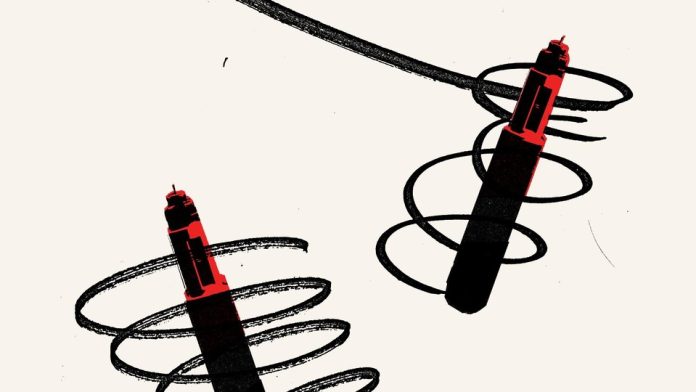Millions more Americans are now eligible for obesity drugs. But the injections remain maddeningly hard to find.
The irony undergirding the new wave of obesity drugs is that they initially weren’t created for obesity at all. The weight loss spurred by Ozempic, a diabetes drug in the class of so-called GLP-1 agonists, gave way to Wegovy—the same drug, repackaged for obesity. Zepbound, another medication, soon followed. Now these drugs have a new purpose: heart health.
On Friday, the FDA approved the use of Wegovy for reducing the risk of heart attack, stroke, and death in adults who are overweight and have cardiovascular disease. The move had been anticipated since the publication of a landmark trial in the fall, which showed the drug’s profound effects on cardiovascular health. The decision could usher in a new era where GLP-1 drugs become mainstream, opening up access to millions of Americans who previously didn’t qualify for Wegovy.
Some of the obstacles stopping people from getting the drug may also begin to crumble. Insurance companies commonly deny coverage of Wegovy because obesity is seen as a cosmetic concern rather than a medical one, but that argument may not hold up for cardiovascular disease. “This new FDA indication is HUGE,” Katherine Saunders, an obesity-medicine physician at Weill Cornell Medicine, told me in an email. Wegovy may soon be within reach for many more Americans—that is, if they can find it.
In practice, Wegovy is maddeningly hard to get hold of. Shortages of injectable semaglutide, the active ingredient in Wegovy and Ozempic, have been ongoing since March 2022; currently, most doses of Wegovy are in limited supply. As the popularity of semaglutide has skyrocketed, demand has completely outstripped the capacity of its manufacturer, Novo Nordisk. The drug comes in injection pens containing a glass vial; “these are not easy products to make,” Lars Fruergaard Jørgensen, the CEO of Novo Nordisk, said in August. In response to the shortages, the company withheld its supply of lower Wegovy doses last year. Because treatment on the medication must begin in low doses, this meant that new patients who wanted to start on Wegovy functionally couldn’t. In January, the company began “more than doubling the amount of the lower-dose strengths” of the drug, a Novo Nordisk spokesperson told me, and it plans to gradually increase overall supply throughout the rest of the year.
The ongoing shortages have left providers and patients feeling stuck. “It is devastating to prescribe a lifesaving medication for a patient and then find out it’s not covered or we can’t locate supply,” Saunders said. Doctors are scrambling to make do with what’s available. Ivania Rizo, an endocrinologist at Boston Medical Center, told me she has had to turn to older GLP-1 drugs such as Saxenda to “bridge” patients to higher doses of Wegovy, although now that is in shortage too. Patients can spend each day calling pharmacy after pharmacy in search of one with Wegovy in stock, Rizo said. In desperation, some have turned to versions of the drug that are custom-made by compounding pharmacies with little oversight, despite the FDA expressing concerns about them. The shots are supposed to be taken weekly, but others have attempted to stretch their doses beyond that.
That the new FDA approval could very mainstream obesity drugs may create long-needed pressure to help resolve these shortages. It makes clear that Wegovy is a lifesaving medication not only for people with obesity but also for those with cardiovascular disease—the leading cause of death in the U.S.—putting the impetus on Novo Nordisk to ramp up production. But in the short term, the access issues may persist. “The new approval is very likely to worsen shortages, because the demand for Wegovy will continue to climb—now at an even faster pace,” Saunders said.
If patients think they’re stuck now, they’re about to feel entrenched. Wegovy is the only obesity drug that has been approved to reduce the risk of heart attacks, but none of its competitors is easily available either. Supplies of certain dosages of Eli Lilly’s Mounjaro, a diabetes drug whose active ingredient is sold for obesity as Zepbound, are limited, and shortages are expected later this year. “We need supply to increase dramatically,” Saunders said. Both Novo Nordisk and Eli Lilly have invested heavily in expanding production capacity, but some of the new plants won’t open until 2029.
For all of its advantages, the FDA approval has a sobering effect on the unrelenting hype around GLP-1s. So much of the excitement around obesity drugs has focused on the future, as dozens of pharmaceutical companies develop more powerful drugs, and commentators imagine a world without obesity. In the process, the issues of the present have gone overlooked. More drugs won’t make much of a difference if the drugs themselves are out of reach.
Source link
Yasmin Tayag














